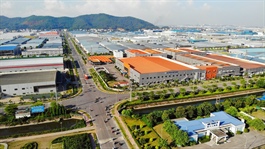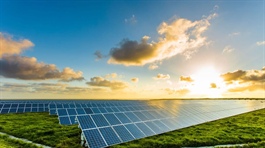Paving the way for Vietnamese fruit to Europe
Paving the way for Vietnamese fruit to Europe
International Port Engineering & Investments (IPEI), a logistics enterprise from Belgium, aims to become a reliable companion of Vietnamese farmers. Marc Stordiau, CEO of IPEI, and Nguyen Thanh Duong, head of IPEI’s representative office in Vietnam, explained to Hoang Oanh how the company is assisting farmers in accessing sustainable, energy-saving solutions and crafting a more favourable European export journey for Vietnamese fruit and vegetables.
Sustainable production and building a value chain for agricultural products for export is a matter of concern to the whole world. What ideas does IPEI have to support Vietnam in establishing and developing a modern supply chain?
When deciding to invest in Vietnam, IPEI has determined that the main purpose is to support fruit farmers to develop the market and build a stable supply in the EU or other potential markets at higher prices.
But the process of realising that goal is not easy when the understanding of logistics, product preservation methods and finding opportunities to penetrate this potential market of Vietnamese farmers are lacking.
How can heating be avoided when bringing fresh fruit to the river via baskets or buckets?
With support from the European Union, IPEI has established a Euro-Vietnam joint venture. They are also actively looking for partners who are Vietnamese enterprises to promote the export of local fresh fruit on the principle that fresh fruit is more environmentally friendly than frozen fruit and they have a better market value.
IPEI has completed research for development of smart logistics chains for the Mekong Delta and southeast of Vietnam. The research results aim to establish the first fruit cooling corridor along the Hau River area. The corridor will include many small cool storage stations located in the centre of the growing area so that when the harvest is complete, farmers can put the fruit directly into the cool storage, ensuring maximum product quality and shortening travel time.
The river container will then be brought back to gather at Can Tho Port, the export gateway of the entire Mekong Delta region. This process ensures that the fruit after harvest always maintains a storage temperature of 2-8 degrees Celsius until it reaches the final client in Europe.
Elsewhere, we set up the first cabin in Cang Long district of Tra Vinh province in 2021 under the sponsorship of the FinExpo fund from Belgium.
The cool storage station has been put into operation and achieved quite satisfactory results. This is also a place to test the process, time, and quality to have the best parameters for the development and expansion of the project later.
Why did IPEI choose the Mekong Delta to build its first cool storage chain and what is the company’s criteria when choosing a development location?
The Mekong Delta is the largest fruit growing area in Vietnam with an area of about 300,000 hectares and a yield of nearly four million tonnes per year. This area also has a dense network of rivers, which supports the transportation of fruit by water at low cost.
In addition, Vietnam also owns another potential fruit growing area, the Central Highlands. But in order to export fruit from there, it must go through a transhipment point to reach the main port located in the Mekong Delta.
The complex logistics process certainly affects the economic problem and increases the emission rate, contrary to the energy saving criteria that the project has set.
Meanwhile, the transportation of fruit products in the northern Red River Delta region will also take 1-2 more days to reach the main export port. This is also not the focus of the fruit growing area and has enough output to carry out projects like this.
Therefore, IPEI determines that the Mekong Delta will be a key area for the company to focus on developing a network of cold fruit preservation for export to markets of high potential such as Europe, the United States, and the Middle East.
How is your mechanism to help preserve and improve the quality of exported fresh fruit different from commonly used freezing methods?
Fruit after harvest will have two routes to export. Via air is fast, but it is expensive and cannot transport large quantities. Sea shipping is still the optimal solution because of its high economic efficiency, but it also poses a challenge in terms of preservation because the journey from Vietnam to the nearest EU port in Spain has taken about 30 days.
The most popular method of fruit preservation today is freezing below -45 degrees, then maintaining cold storage from -20 to -25 degrees and defrosting after reaching the market.
This method helps to preserve fruit for a long time, but after defrosting the fruit will spoil rapidly. It is also energy-consuming because the containers have to regularly consume large amounts of electricity to maintain a low temperature. There have also been many new technologies to overcome the limitations of the traditional freezing method, but the cost is 5-6 times more expensive.
The series of smart cabins developed by IPEI will operate according to the criterion of energy saving, one of the most important standards in Europe at this time. The cabin will be set up near the plantation area so that the fruit can be kept cool from 2-8 degrees after harvesting, reducing the transportation distance. These cabins are also located near shipping routes, near ports with infrastructure for cold storage containers, connecting waterways and roads to major ports in the region.
The cooling method not only saves energy, but also helps buyers and sellers to track the journey and control the environmental conditions inside the shipment remotely through smart control sensors.
However, this method also has a weakness in that the length of the fruit life cycle is not equal to cold storage and not all fruit can be kept cool. Such fruits include longan, avocado, and also mangosteen.
What are the plus points that make IPEI’s project more attractive compared to other cooler cabin projects?
Currently, many large Vietnamese enterprises in the agricultural sector such as Nafoods Group, Vina T&T Group, and Hoang Anh Gia Lai all have their own cool storage system, but while technology can be funded,the main problem of all businesse is the need for stable output.
As I stated at the outset, the EU aid for the project is to help Vietnamese farmers consume refrigerated fruit through cooperatives or small businesses. The first form of support is a loan for eight years with an interest rate of 2 per cent per year. When the term ends, the Vietnamese partner will be able to buy back the cool storage station for a symbolic price of $1.
The second form is an incentive to reduce investment capital up to 35 per cent when buying numerous storage stations.
If you join the cycle from the beginning, small businesses and cooperatives will have a huge advantage to build brands. Of course, they can develop their own brand when combined with other cool storage chains, but that also means they can’t compete with businesses participating in our project.
We will support businesses and member of cooperatives to connect with fruit importers from Europe. Farmers will benefit from exporting fruit to markets with higher prices, better income, and greater stability. As long as they grow and preserve fruit according to the standards, they will no longer worry about being pressured by traders.
The business side will have to compete to participate in the system, with benefits depending on their willingness to cooperate.
They can also run their own business, train farmers, develop their own growing areas, harvest and sell fruit products through cool storage, or they can manage and lease back the cool storage chain to other businesses to export fruit to Europe.
After a year of testing and preparing to expand, how do you evaluate the performance and value of the cold storage chain with beneficiaries, especially farmers?
We rate the model as positive because as long as there is a stable source of purchase, the owners of the cool storage stations can completely run their own business or lease the service.
When the energy issue is particularly concerned in Europe, businesses or cooperatives accompanying IPEI can fully take advantage of the energy-saving advantages of the system to develop their brands.
I’m thinking of an interesting slogan, for example: “Eat preserved fruit from Vietnam and save energy”. Such slogans will easily impress and make Vietnamese fruit more advantageous to conquer Europe.
Currently, Vietnamese fruits are still mainly exported in raw state to the Chinese market, then processed and labelled with China for export to the US or Europe. Meanwhile, Europe is the world’s largest fruit consumption market, and Vietnam with a complete seasonal variety of products can develop in this market.
Projects like IPEI are a stepping stone to spread the Vietnamese fruit brand to European consumers, and at the same time open a journey of more sustainable production and consumption, contributing to raising the level of Vietnamese agricultural products.



















